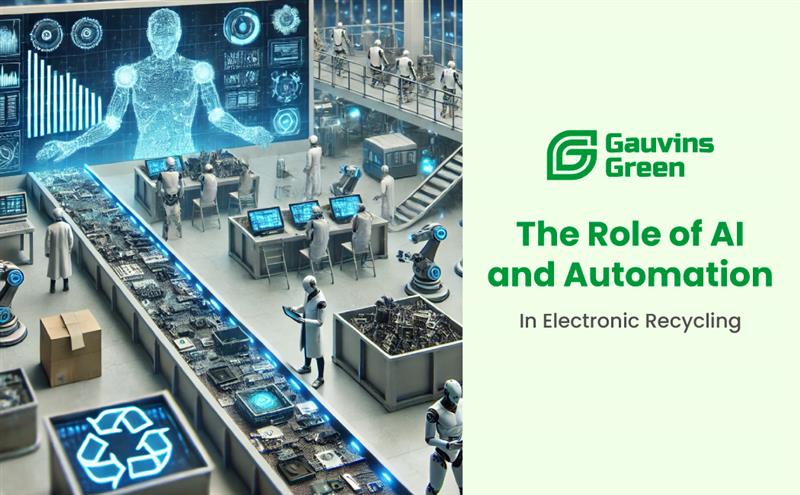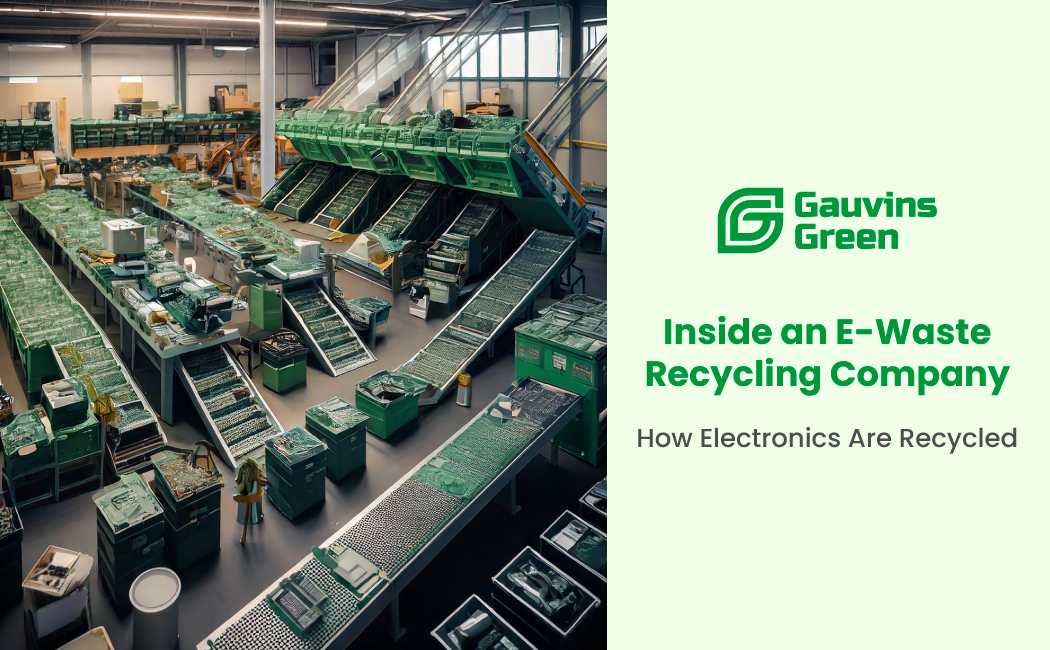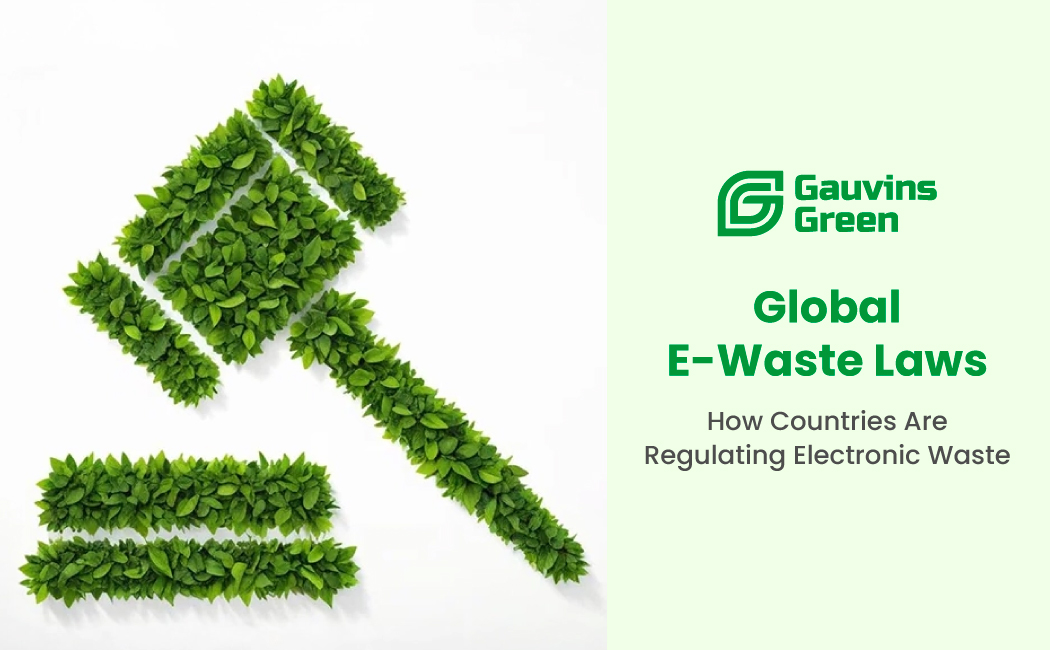Electronic waste (e-waste) is a waste stream that is growing globally the fastest and is one of the most environmentally harmful industries in the world. The volume of electronic recycling garbage, that is produced as technology improves, also rises significantly. The traditional method of recycling struggles to match this constant rise, thus, leading to e-waste management inefficiencies. This is where Artificial Intelligence (AI) and Automation become an integral part of the revolution of e-recycling by improving sorting, processing, and recovery.
Leading e-waste recyclers such as Gauvins Green are now pioneers in using these technologies in the field of reusing electronic recycling sustainably and effectively thereby promoting the environment.
Understanding AI and Automation in E-Waste Recycling
AI and Automated Systems using powerful algorithms, made with high-precision Robotics and sensors, as well as smart devices are the means of the electronic recycling process enhancement. Robotics technology is smart enough to find valuable materials and consists of powerful AI algorithms and the use of computer vision to sort materials.
Furthermore, the technological powers behind this process help the smart machines to distinguish between different types of electronic recycling wastes, consequently, reducing the contaminations while materials are recovered with higher efficiency.
Gauvins Green’s e-waste management services help the world’s level of e-waste pollution by applying AI solutions that work with material recycling and are efficient and environmentally friendly.
AI-Powered E-Waste Sorting and Processing
Sorting electronic recycling e-waste by hand is time-consuming and is very likely to have errors. However, AI-based automated sorting systems have undergone a paradigm shift in this process via:
- Image Recognition & Machine Learning – Cameras and sensors based on AI technology far-sight multiple materials, such as polymers, metals, and circuit boards, and assist in their appropriate categorization.
- Robotics Sorting – AI software-integrated robotic arms are used to smooth out the separation of reusable from throw-away waste, as a result, resource recovery has been optimally improved.
- A robot-controlled Conveyor Belt System – conveyor belts operated by artificial intelligence technologies scan and sort out the materials that are a composition of them to activate the segregation of waste.
At Gauvins, the AI-powered sorting technology is the key to the improvement of operational efficiency by replacing manual error with a high-tech solution and by recycling more material which causes less accumulation of landfills.
Enhancing Efficiency with Automated Data Destruction
E-waste recycling also involves secure data destruction to prevent unauthorized access to sensitive information stored on discarded electronic recycling devices. Gauvins Green ensures 100% data security through AI-driven techniques like:
- Data Erasure Software – AI-based tools, such as Blancco, wipe out data completely before electronic recycling assets.
- Data Degaussing – This technique uses electromagnetic fields to erase data from hard drives, making recovery impossible.
- Hard Disk Shredding – AI-powered shredders destroy hard drives into tiny fragments, eliminating any risk of data breaches.
By incorporating AI automation, Gauvins Green guarantees secure IT asset disposal, helping businesses maintain data privacy while responsibly recycling e-waste.
Smart Reverse Logistics for E-Waste Collection
Effective collection of e-waste for recycling is the thing that would help in the success of recycling. AI-driven Reverse Logistics Systems optimize the collection process by:
- GPS Tracking & Route Optimization – AI-powered applications determine the shortest possible routes for the waste collection which results in less fuel consumption and carbon footprint.
- Automated Pick-Up Scheduling – AIs allow customers to schedule e-waste pick-ups, which ultimately guarantees more comfort and faster disposal.
- Inventory Management – AI is a huge tool in recognizing the collected e-waste, and marking it as per the type, condition, and smart waste management capacity of recycling.
Gauvins Green incorporates AI-infused reverse logistics that help to collect e-waste in a way that is convenient for both involved businesses and consumers.
The Role of Gauvins Green in AI-Driven E-Waste Recycling
As the leading recycling company for e-waste, Gauvins Green places a keen focus on AI and automation in the course of the recycling process to help clean the environment. It does this through:
- Enhance Material Recovery – The AI-based technology features a sorting function that boosts the probable extraction of such valuable materials as copper, gold, and silver from the rest of the slag.
- Ensure Compliance with EPR Regulations – Gauvins Green implements Extended Producer Responsibility (EPR) guidelines that make e-waste disposal compliant with government regulations.
- Promote Sustainable Recycling – As Gauvins Green implements more green electronic recycling waste solutions, they become one of the entities that are a stepladder for attaining the goal of a circular economy.
- Provide End-to-End ITAD Services – AI-based IT Asset Disposal (ITAD) solutions make the process of safely decommissioning old IT devices as well as maximizing resource recovery easier for businesses.
Benefits of AI and Automation in E-Waste Recycling
The combination of artificial intelligence and automation in electronic recycling has brought various benefits to the table:
- Increase in Efficiency – AI-based systems analyze e-waste more quickly than the manual method, thus lessening the turnaround time.
- Higher Precision in Sorting – Machine learning models with advanced capabilities make the distinction between materials more accurately, which then leads to a higher recycling rate.
- Less Impact on the Environment – Automatical systems recycling has a recycling process that optimizes the materials recovery while recyclables are not taken to landfills.
- Cost Reduction – Automation cuts the costs for the workers and brings the operations to a level that is more economical when recycling.
- Safety Improvements – AI-operated robot manages dangerous electronic recycling waste parts, thus decreasing the danger associated with the exposure of humans to harmful substances.
Challenges and Future of AI in E-Waste Management
Conversely, AI and automation are their heavy-duty electronic recycling gear; however, it is not devoid of trouble:
- High Implementation Costs – AI technology is quite expensive and requires a large capital investment, which means that the smaller recycling companies find it hard to adopt.
- Technical Limitations – AI-powered systems need to be regularly updated and maintained to work effectively.
- Workforce Training – Employed AI and the rest mechanical devices should be operated, maintained, and managed by qualified staff such as an AI engineering workforce.
- E-Waste Regulations Evolution– the e-waste recycling eco-systems are always required to be updated, and the condition is always the same.
Future Prospects
AI in e-waste recycling shows a strong future outlook, mainly due to the following:
- AI-Powered Predictive Analytics – Machinery will help recyclers predict e-waste generation and plan better.
- Blockchain Integration – Technologies to track e-waste life cycles to help visualize what sector of the supply chain is causing problems.
- 5G-Enabled Smart Recycling – This includes the high-speed delivery of information to the operator for more efficient recycling.
- Autonomous Robotic Dismantling – The ability of a robot to separate recycled products will make the recycling process much more effective and faster.
Conclusion
By using artificial intelligence and robotic process automation (RPA) in e-scrap recycling, the actual operations are becoming shorter, cheaper with the same time and energy, and also more environmentally sound. Gauvins Green is amongst the tech companies using AI-driven waste recycling solutions that guarantee material recovery, data safety, and compatibility with environmental regulations. Progress in AI should result in e-waste recycling design, which will be ecologically friendly and accompanied by new technology that will be possible to be adopted by other industries.
Whether the means of collecting discarded electronic recycling goods for recycling or the treatment of this waste is concerned, artificial intelligence machines and other state-of-the-art machines can play a major role in solving the problem of electronic recycling waste. Let us together turn e-waste recycling on its head by adopting AI and automation, join Gauvins Green in the process!



